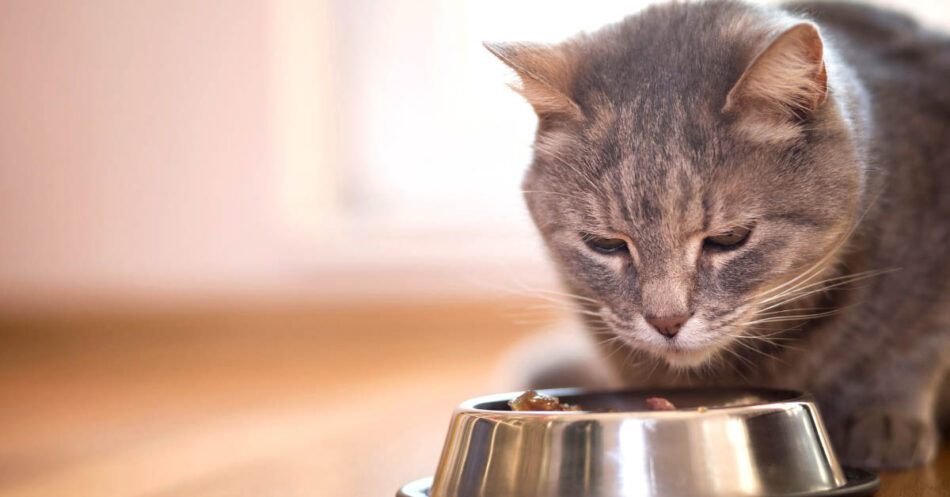
7 Things to Do Right Now to Help Your Fat Cat Lose Weight
Pudgy kitten bellies may be the cutest thing ever, but when adult cats pack on the pounds, it can lead to poor health. A clinical study done by Banfield Pet Hospital showed that the rates of obese cats and dogs in the United States have more than doubled since 2010. Some veterinarians estimate that as many as 50% of cats are overweight or obese. Helping your cat lose weight, or maintain her healthy weight, is important for her health and well-being.
An extra pound or two on our cats may not seem like a big deal, but overweight or obese cats are at risk for many health problems. We all want our furry friends to live long and healthy lives, and keeping them at a healthy weight is a big part of that (that’s why you searched for “how to help cat lose weight” in Google after all).
Here’s how to tell if your cat is overweight and, if she is, seven things you can do to help your cat lose that excess weight.
Is My Cat Overweight?
While overfeeding cats will lead them to gain weight, there can be other reasons behind an overweight kitty. Even if you don’t change your cat’s food or portions, she may become overweight over time. As cats get older, their activity level goes down. Since they’re burning fewer calories, they may gain weight.
Some cat breeds are more likely to gain weight than others. Spayed or neutered cats naturally have a slower metabolism and an increased appetite and will gain weight more easily if overfed. Some cats aren’t as active or energetic as others and may require less food. Some cats may be bored and eat to entertain themselves.
Because every cat is different, it’s a good idea for pet parents to give their cats a monthly once-over to spot any changes. For a FREE monthly health checklist, click below.

Part of that monthly at-home checkup should be monitoring your cat’s body condition. In other words, check to see if your cat is overweight.
First, look at your cat from above. You want to see an indent or waist behind the ribcage—like a kitty hourglass figure.
Next, look at her from the side. Is her belly hanging down and rounded? Some cats at a healthy weight naturally have a little “pouch” hanging down (called the primordial pouch), so feel to see if it’s skin or if it’s fat. If it swings easily from side to side when she walks, it’s probably just skin.
Finally, feel her ribs and along her spine. You want to be able to feel the ribs easily without pressing too hard. The same goes for the spine. This doesn’t mean you should be able to see the ribs or spine—that would mean your cat is underweight—but she shouldn’t be buried under excessive fat.
If your examination suggests your cat is overweight, it’s important to start helping her with weight loss immediately.
Pin Me!
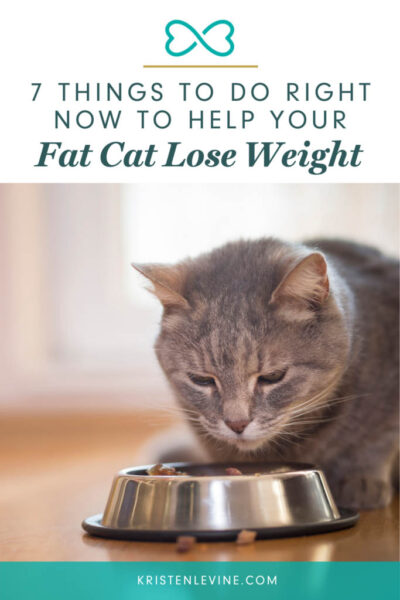
Health Risks Faced by Overweight or Obese Cats
Overweight or obese cats face significant health risks that can affect their quality of life and how long they live. The most common disorders associated with excess weight in cats include:
- Type 2 diabetes: Obese cats are three times more likely to develop this serious disease compared to normal-weight cats.
- Heart disease: This is a prevalent condition in overweight cats.
- Osteoarthritis: Also known as arthritis, this is often made worse by the extra weight on your kitty’s joints.
- Increased frequency of joint injuries: Because of your kitty’s body weight, there’s added stress on her joints.
- High blood pressure: Like humans with abnormal body weight, this is a common issue in overweight cats.
- Certain forms of cancer: Intra-abdominal cancers are more likely in obese cats.
- Urinary bladder inflammation: Overweight cats, especially males, are more likely to have urinary trouble, including life-threatening urine blockages.
Cat obesity also affects your kitty’s overall well-being and behavior. Overweight cats tend to have shorter lives, less interaction with their families, and decreased energy and playfulness.
Their reduced activity levels can make it difficult to notice early signs of illness, as their “laziness” might be misinterpreted as normal behavior. Obesity also hinders a cat’s ability to groom themselves and to move naturally, leading to potential skin conditions and exacerbated joint issues.
7 Ways to Help Your Cat Lose Weight
While it can be daunting trying to figure out how to help a cat lose those extra pounds, there are many different things you can do. Here’s how to help your cat shed those extra pounds and keep it off:
1. Talk to your veterinarian.
Your veterinarian is the best person to determine if your cat is overweight. They also can make sure there aren’t any serious medical conditions that are contributing to your kitty’s extra pounds. If your veterinarian determines that your cat needs to lose weight, he or she can discuss a weight loss program or diet plan with you and also tell you how to help your cat lose weight slowly, safely, and effectively.
Pet parents may be reluctant to spend money on a veterinary visit when their cat isn’t sick, but getting your feline friend help now can save money later by preventing many illnesses related to abnormal weight gain.
2. Don’t free feed.
“Free feeding,” or leaving food out all the time for your cat to eat whenever she wants, is very convenient, especially for pet parents who work long hours. However, your cat may eat too much if food is always available, especially if she gets bored. Also, it is in a cat’s natural instinct to always eat a little more than needed, in case another meal doesn’t come around.
Your veterinarian’s diet plan will likely include information about portion sizes. A timed feeder will let you control your cat’s portions while also keeping her fed when you’re away from home.
3. Play with your cat more.
Playing with your cat is a great way to help them burn calories while also giving you some fun quality bonding time. Playtime should be fun and in moderation—your cat shouldn’t be panting or exhausted at the end.
Cats don’t need long playtimes. A few short playtimes every day that run 5–10 minutes are better than one long session—this promotes healthy weight loss without stressing your kitty too much. If your cat walks away during playtime, let her go, as she may be getting overstimulated.
There are countless cat toys to choose from (you can find some of our favorites on this blog post or this Amazon list). Every cat is different, so it may take some experimenting before you discover their favorite way to play.
For more ways to bond with your cat, download the free guide below.
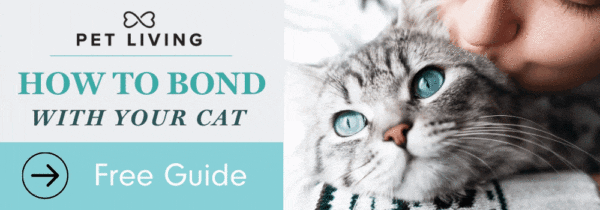
4. Take them for walks on a harness and leash.
It may seem strange to think of walking your cat like you would a dog, but it is possible to take your cat for a walk and let her enjoy the outside world. In fact, it can be a more fun and exciting way to promote weight loss! Unlike when you walk a dog, be prepared to go at your cat’s pace and occasionally take some time to smell the roses—or maybe just watch some birds.
Be sure to buy a harness and leash that are specially designed for a cat. Cats have less muscle around their neck than dogs and can become injured if walked on a traditional collar and leash.
It can take some time for your cat to get used to walking on a leash with a harness. The younger they are, the easier it will be to introduce them to the harness and all the possibilities that leash-walking can provide. If you need ideas, check out this book on the best adventures to have with your cat!
5. Evaluate the treats you give them.
Most cats love treats, and seeing them get excited for a favorite treat can be a lot of fun. They also can be helpful as positive reinforcement for good behavior.
Treats can add a lot of calories, though, so it’s important to monitor them, especially when your cat is on a weight-loss program.
Cutting out or limiting the number of treats you feed your cat can help her achieve her ideal body weight. If you don’t want to cut out treats entirely, look for low-calorie treats like these. Ask your veterinarian what treats are allowed on your cat’s diet plan and how many of them you can give.
6. Add some water to their food.
Just like with people, water can help your cat feel full. If your cat isn’t in the habit of drinking water on her own, making it more enticing can help. One easy way to do this is with a cat water fountain.
Besides making sure fresh, clean water is always available, you can help your overweight cat lose some pounds by adding some water to her food.
This is especially true with dry food. If you give your cat dry food, adding a little water and swirling it around for a few seconds can make a light “gravy” that your cat is likely to lap up. Keeping your cat hydrated is always good, and the extra water can help her feel fuller.
7. Be patient.
Helping your cat lose weight takes time. This isn’t just because it can be hard – it’s because it’s the only healthy way to do it.
If a cat isn’t fed regularly, her body starts breaking down fat for energy. While you do want your cat to lose fat, if too much fat is broken down too quickly it will lead to hepatic lipidosis. This is also known as “fatty liver disease,” and it can be life-threatening. This disease appears even more quickly (2-4 days) if the cat is overweight or obese.
This is why it’s so important to speak with your veterinarian about your kitty’s weight and weight loss goals to create a safe plan to get your furry friend to her ideal weight.
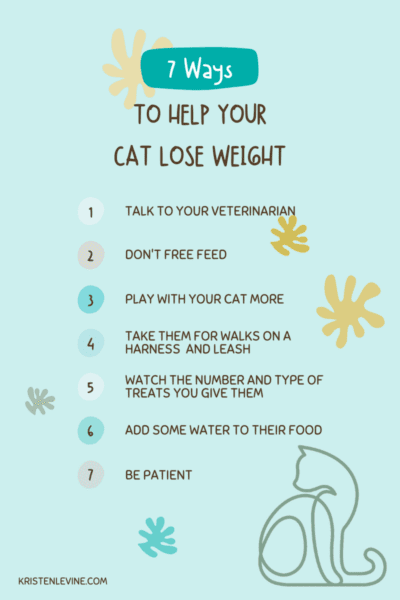
FAQS
How Much Should My Cat Weigh?
The ideal body weight of adult domestic cats should be around 8–12 pounds (3.6–5.4 kg). But a cat’s weight will differ significantly based on the specific breed and individual characteristics of the cat.
For example, a Siamese cat may weigh as little as 5 pounds and still be healthy, while a Maine Coon can weigh up to 25 pounds and be considered in a healthy weight range. Factors such as breed and body frame play a crucial role in determining a cat’s ideal weight.
When Is a Cat Considered Overweight?
Your kitty will be considered overweight when she exceeds her ideal body weight by more than 10% (that’s only 1 extra pound in a 10 lb cat!). At this point, she’s now more prone to health risks associated with this abnormal weight gain. When a cat’s weight is 20% or more above the ideal, she falls into the obese category.
How Much Should I Feed My Cat to Promote Weight Loss?
To promote your kitty’s weight loss, you’ll need to adjust her feeding amount carefully. Your veterinarian may recommend this general guideline: feed your cat about 80% of her resting energy requirement (RER). You can calculate the RER using the formula: RER in kcal/day = 30 (body weight in kilograms) + 70. Make sure your cat doesn’t lose more than 1–2% of their total body weight per week to maintain a safe weight loss pace.
Remember that reducing a cat’s food intake too quickly can lead to loss of appetite, hepatic lipidosis, and vomiting. Although 80% of RER is the goal, reduce food slowly over several months to ensure a safe weight loss rate.
For portion control, some recommendations suggest reducing the daily food intake to 40–50 grams per day, but this should be monitored closely by you and your veterinarian to ensure your cat’s weight loss is safe.
When to Switch Foods
Your veterinarian may suggest a restricted-calorie diet, but remember, you cannot force a cat to eat food she doesn’t like. Unlike dogs, a cat will not “get hungry enough” to eat food if it’s not her preference. If you do switch food, do so slowly, adding small amounts of the new food to the old every day. Over the course of 1-2 weeks, you can have your furry feline adjusted safely to her new food.
Remember, also, that free-feeding diet food does not help obesity, as your cat will likely just consume more food to meet her current weight requirements.
The Tail End
Cat obesity can severely impact your cat’s health and even shorten her life. However, it is preventable and also highly treatable by making sure she’s on a healthy weight-loss program. By speaking with your veterinarian and following the tips listed above, you can help your cat lose weight and live her best life.





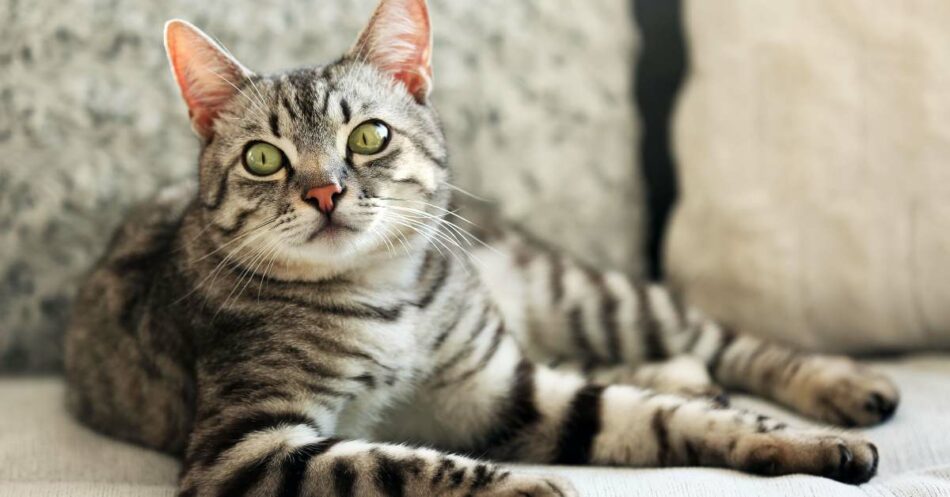
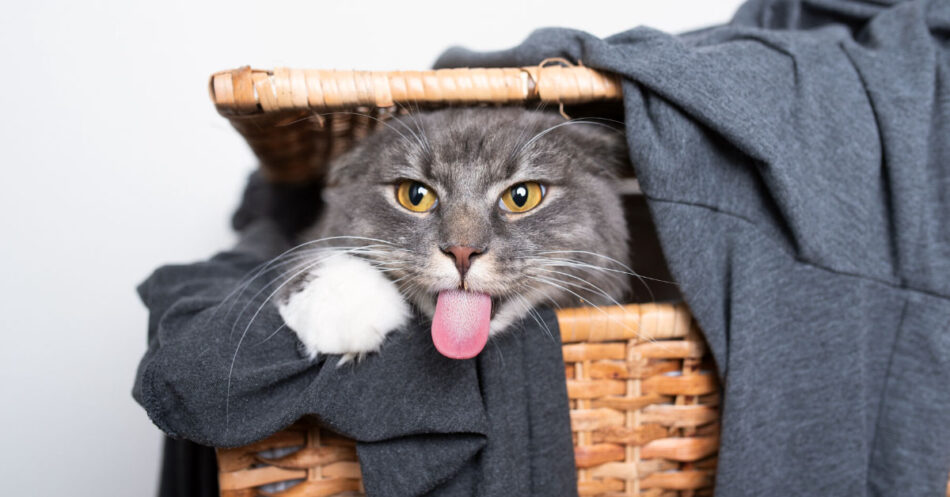
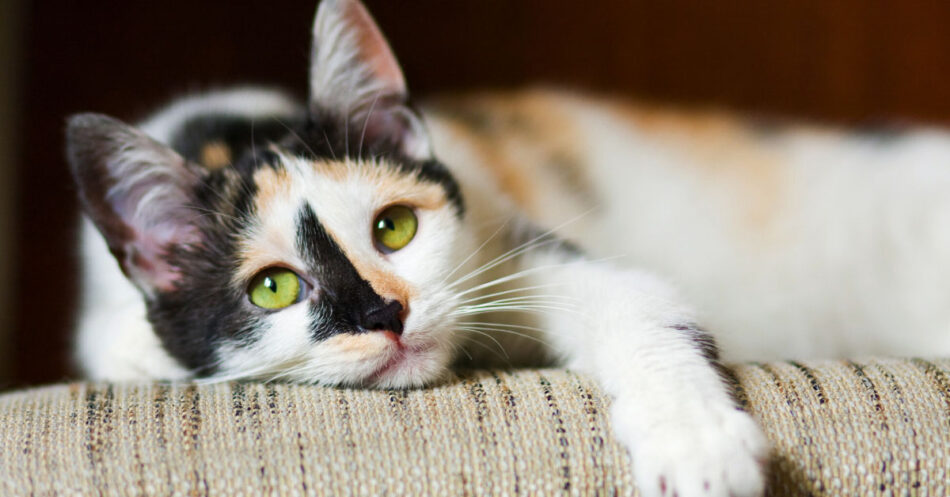
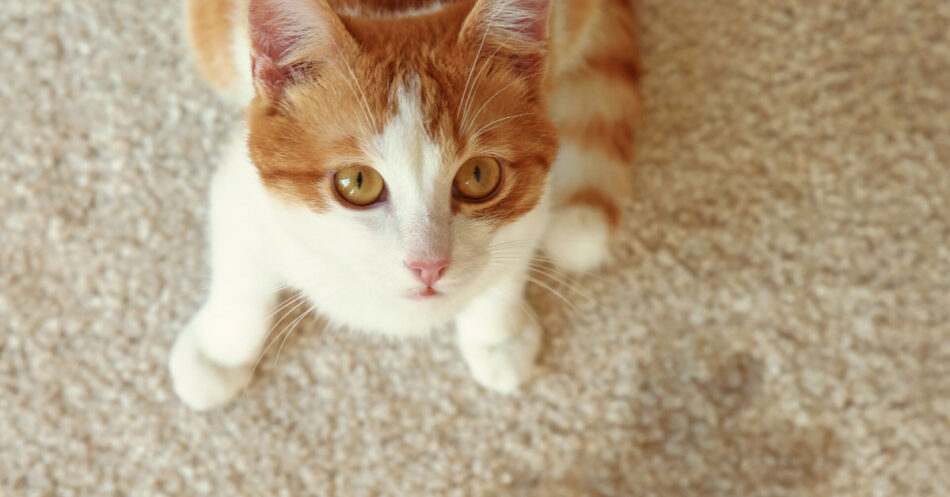
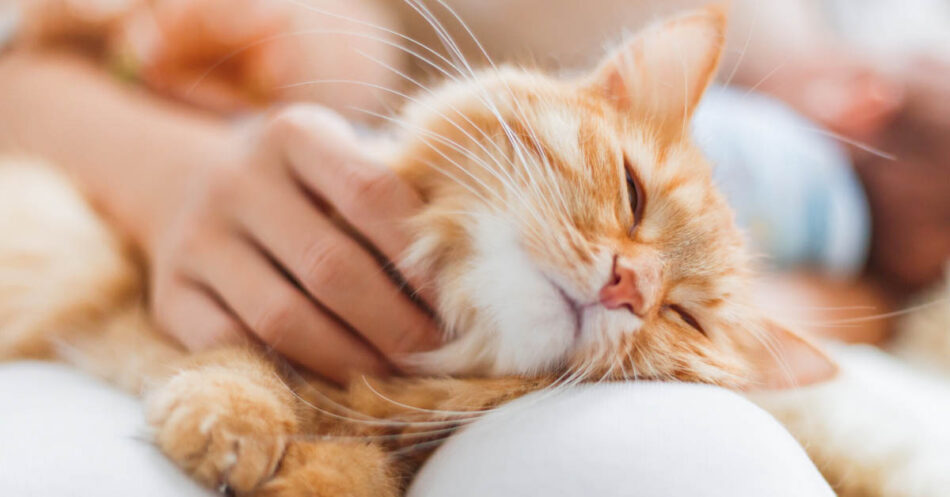
Comments (0)